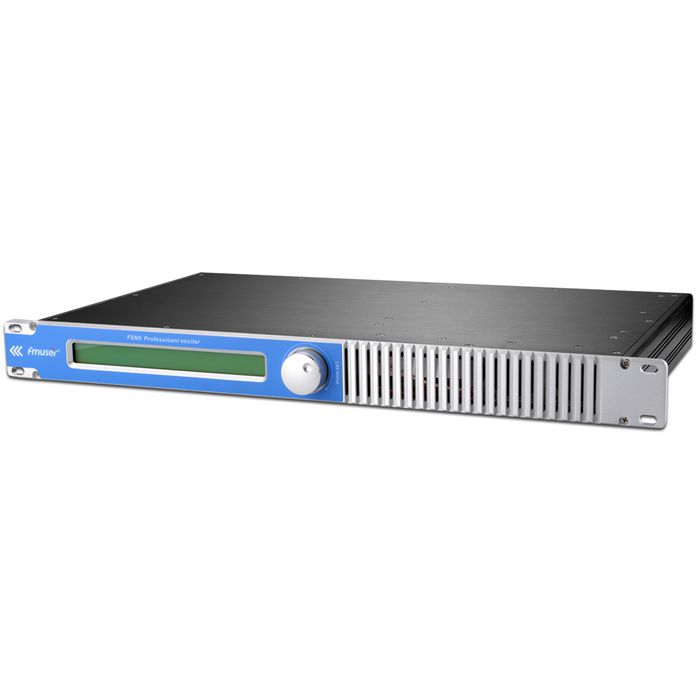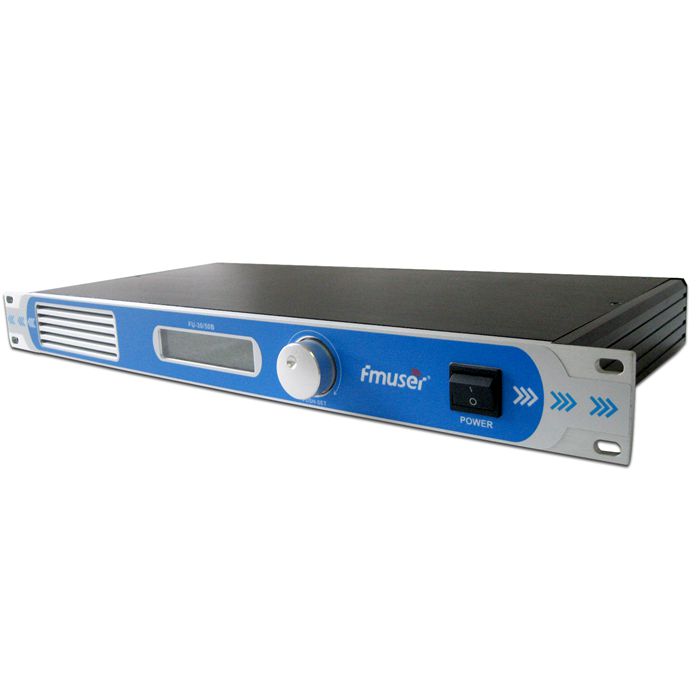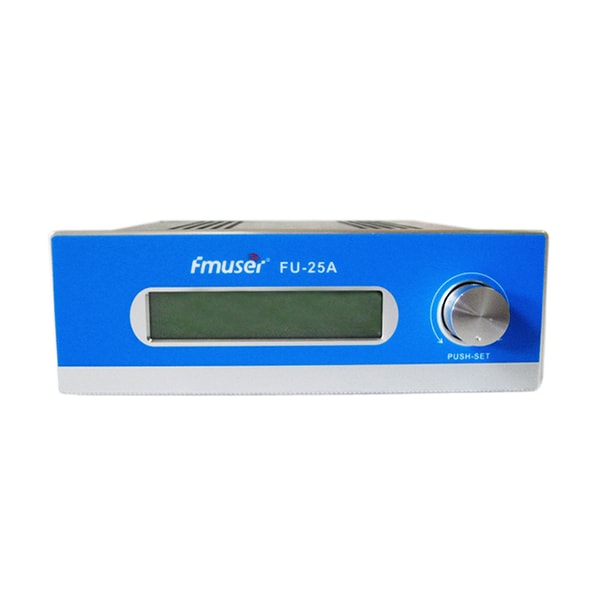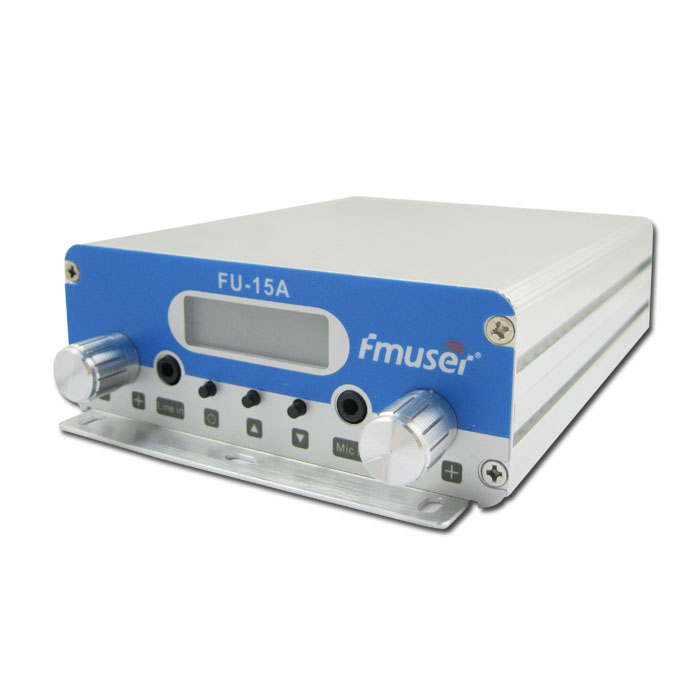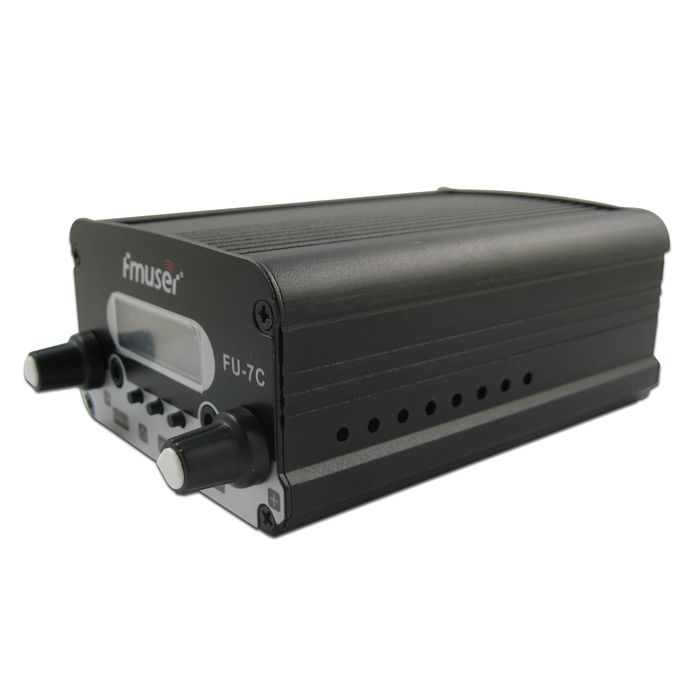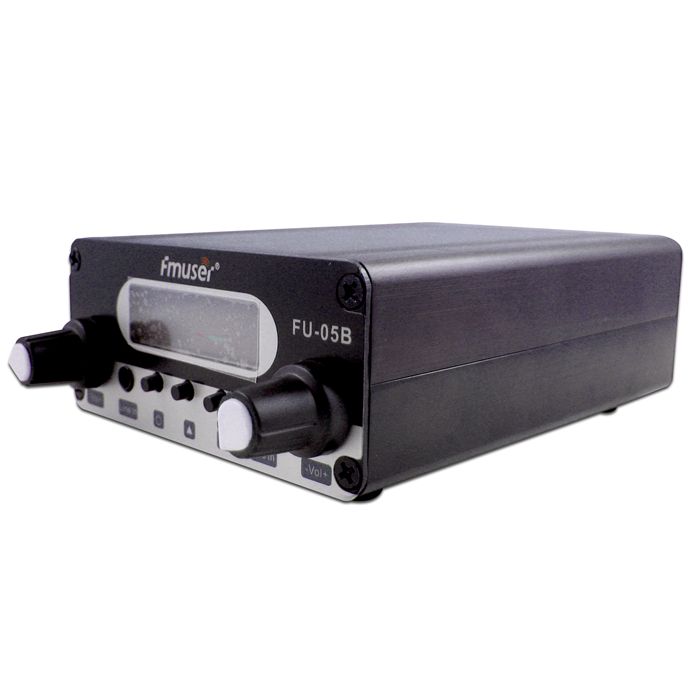
Trasmettituri FM b'Enerġija Baxxa
Trasmettituri FM ta 'enerġija baxxa huma l-aktar komunement użati għax-xandir ta' sinjali fuq distanzi qosra, minn ftit mijiet ta 'saqajn għal ftit mili. L-applikazzjonijiet l-aktar komuni huma għal mikro-xandir u radju komunitarju, kif ukoll għal sistemi tal-awdjo mingħajr fili bi prezz baxx fi knejjes, skejjel u postijiet oħra. Trasmettituri FM ta 'enerġija baxxa jistgħu jintużaw ukoll għall-monitoraġġ tal-awdjo u tal-vidjo mingħajr fili, sistemi ta' konferenzi mingħajr fili, u netwerks tar-radju interni.
-
![FMUSER FMT5.0-50H 50W FM Radio Broadcast Transmitter]()
FMUSER FMT5.0-50H 50W Trasmettitur tax-Xandir tar-Radju FM
Prezz (USD): Itlob għal kwotazzjoni
Mibjugħa: 2,179
It-trasmettitur tar-radju FMT5.0-50H FM huwa affidabbli ħafna, eħfef fil-piż, u aktar faċli biex jopera mill-verżjoni tas-serje preċedenti. FMT5.0-50H tapplika kunċett ta 'disinn ta' stil sempliċi. Tintegra l-exciter tat-trasmettitur stereo FM 50W, amplifikatur tal-qawwa, filtru tal-output, u provvista ta 'enerġija li tiswiċċja f'każ standard ta' 1-il pulzier għoli 19U, li jnaqqas il-kejbils ta 'konnessjoni bejn il-komponenti. Huwa wieħed mill-aqwa trasmettituri tax-xandir użati b'mod wiesa 'f'diversi stazzjonijiet tar-radju żgħar, bħal xandir drive-in theater, xandir drive-in knisja, xandir drive-through test, xandir kampus, xandir komunitarju, xandir industrijali u tal-minjieri, xandir ta' attrazzjonijiet turistiċi , eċċ.
-
![FU-50B 50 Watt FM Transmitter for Drive-in Church, Movies and Parking Lot]()
FU-50B Trasmettitur FM ta '50 Watt għal Drive-in Church, Films u Parking Lot
Prezz (USD): Itlob għal kwotazzjoni
Mibjugħa: 213
-
![FMUSER FU-25A 25W FM Radio Broadcast Transmitter]()
FMUSER FU-25A 25W Trasmettitur tax-Xandir tar-Radju FM
Prezz (USD): Itlob għal kwotazzjoni
Mibjugħa: 198
FMUSER FU-25A (Magħruf ukoll bħala CZH-T251) Trasmettitur tax-xandir FM 25W huwa wieħed mit-trażmettituri tax-xandir tar-radju FM b'enerġija baxxa li l-aħjar bejgħ fl-2021, jaħdem tajjeb u l-aktar applikat fi stazzjonijiet tar-radju tax-xandir ta 'medda medja bħal drive-in -xandir tal-knisja u xandir drive-in-movie, eċċ.
-
![FMUSER PLL 15W FM Transmitter FU-15A with 3KM Coverage (9,843 feet) for Drive-in Church, Theaters and Movies]()
Prezz (USD): Itlob għal kwotazzjoni
Mibjugħa: 1,428
-
![FMUSER FU-7C 7W FM Radio Broadcast Transmitter]()
FMUSER FU-7C 7W Trasmettitur tax-Xandir tar-Radju FM
Prezz (USD): Itlob għal kwotazzjoni
Mibjugħa: 134
It-trasmettitur tax-xandir FM FMUSER FU-7C 7W huwa wieħed mill-aqwa trasmettituri tax-xandir tar-radju FM b'qawwa baxxa ddisinjati apposta għal stazzjonijiet tar-radju FM.
-
![FMUSER FU-05B 0.5W FM Radio Broadcast Transmitter]()
FMUSER FU-05B 0.5W Trasmettitur tax-Xandir tar-Radju FM
Prezz (USD): Itlob għal kwotazzjoni
Mibjugħa: 173
FU-05B huwa wieħed mill-aqwa trasmettituri tax-xandir tar-radju LPFM għal stazzjonijiet tar-radju FM, hija wkoll għażla bi prezz baxx għax-xerrej tat-tagħmir tax-xandir b'baġit baxx li jeħtieġ li jkopri firxa żgħira.
- X'inhu trasmettitur FM ta 'qawwa baxxa?
- Trasmettitur FM ta 'qawwa baxxa huwa tip ta' trasmettitur tar-radju li jxandar fuq il-medda FM b'qawwa aktar baxxa minn trasmettituri FM normali. Is-sinonimu tiegħu huwa trasmettitur LPFM.
- Kif tuża trasmettitur FM ta 'enerġija baxxa fi stazzjon tar-radju?
- 1. Waħħal it-trasmettitur FM ta 'enerġija baxxa fl-istazzjon tar-radju drive-in skond l-istruzzjonijiet tal-manifattur.
2. Aġġusta l-qawwa tal-ħruġ tar-radju sabiex it-trasmissjoni tibqa 'fil-limiti legali.
3. Qabbad it-trasmettitur mas-sors tal-awdjo u kun żgur li l-awdjo qed jasal għat-trasmettitur.
4. Intuna t-trasmettitur għall-frekwenza mixtieqa u ssorvelja s-saħħa tas-sinjal fuq skaner tal-frekwenza.
5. Evita kwalunkwe interferenza ma 'sinjali tar-radju oħra fiż-żona.
6. Spezzjona regolarment it-trasmettitur biex tiżgura li ma jkunx hemm problemi bil-qawwa tal-ħruġ tar-radju.
7. Kun żgur li żżomm it-trasmettitur 'il bogħod minn kwalunkwe tagħmir elettriku b'qawwa għolja li jista' jikkawża interferenza.
8. Tissorvelja s-saħħa tas-sinjal u l-kwalità tal-awdjo tat-trażmissjoni biex tiżgura li hija konformi mal-istandards.
- Kif jaħdem trasmettitur FM ta 'qawwa baxxa?
- Trasmettitur FM ta 'qawwa baxxa jaħdem billi jibgħat sinjal tar-radju minn antenna tat-trasmettitur għal antenna riċevitur li tinsab f'kull vettura fl-istazzjon tar-radju drive-in. Is-sinjal jixxandar fuq frekwenza FM apposta u jiġi riċevut mir-riċevitur tar-radju tal-karozza. Is-sinjal imbagħad jista 'jinstema' fis-sistema tal-awdjo tal-vettura, li jippermetti lis-sewwieq u lill-passiġġieri jisimgħu x-xandir awdjo.
- Għaliex trasmettitur FM ta 'enerġija baxxa huwa importanti għal stazzjon tar-radju?
- Trasmettitur FM ta 'enerġija baxxa huwa importanti għal stazzjon tar-radju drive-in għaliex jippermetti firxa akbar ta' firxa ta 'xandir. Trasmettituri FM ta 'enerġija baxxa huma ddisinjati biex ikopru żona iżgħar minn trasmettituri FM ta' qawwa sħiħa, għalhekk huma adattati aħjar għax-xandir fuq żona limitata bħal stazzjon tar-radju drive-in. Dan it-tip ta 'trasmettitur huwa meħtieġ għal stazzjon tar-radju drive-in għaliex jippermetti lill-istazzjon jilħaq l-udjenza maħsuba tiegħu filwaqt li jimminimizza l-interferenza ma' stazzjonijiet oħra.
- X'inhuma l-aktar qawwa tal-ħruġ li tidher ta 'trasmettitur FM ta' qawwa baxxa, u sa fejn jistgħu jkopru?
- L-aktar qawwa tal-ħruġ li tidher ta 'trasmettitur FM ta' qawwa baxxa hija tipikament bejn 10 u 100 Watts. Dan it-tip ta 'trasmettitur jista' jkopri distanza sa 5 mili (8 kilometri), skond it-terren lokali u fatturi oħra.
- Kif tibni pass pass stazzjon tar-radju FM komplut b'trasmettitur FM ta 'qawwa baxxa?
- 1. Irriċerka r-rekwiżiti għat-twaqqif ta 'stazzjon tar-radju FM ta' qawwa baxxa fiż-żona tiegħek. Dan tipikament jinkludi l-kisba ta 'liċenzja mill-FCC.
2. Akkwista t-tagħmir u l-provvisti meħtieġa. Dan jinkludi trasmettitur FM, antenna, proċessur tal-awdjo, mikrofonu, mixer tal-ħoss, u tagħmir ieħor tax-xandir.
3. Waħħal it-trasmettitur u l-antenna f'post xieraq. Din għandha tkun żona b'interferenza minima minn trasmissjonijiet oħra tar-radju.
4. Qabbad it-trasmettitur mal-proċessur tal-awdjo, mixer, u tagħmir ieħor.
5. Intuna t-trasmettitur għall-frekwenza mixtieqa u aġġusta s-settings tal-awdjo għall-preferenzi tiegħek.
6. Oħloq skeda tal-programm u rrekordja jew akkwista kontenut għall-istazzjon.
7. Ittestja l-istazzjon biex tiżgura li qed ixandar b'mod korrett. Agħmel kwalunkwe aġġustamenti meħtieġa.
8. Ibda xxandar l-istazzjon tiegħek!
- Kemm jista 'jkopri trasmettitur FM ta' qawwa baxxa?
- Il-firxa ta 'trasmettitur FM ta' qawwa baxxa tista 'tvarja skont l-output tal-enerġija u t-terren li jkun qed jintuża fih. Ġeneralment, trasmettituri FM ta 'enerġija baxxa jistgħu jkopru distanza sa 3 mili (4.8 kilometri).
- X'jiddetermina l-kopertura ta 'trasmettitur FM ta' qawwa baxxa u għaliex?
- Il-kopertura ta 'trasmettitur FM ta' qawwa baxxa hija ddeterminata mill-output tal-qawwa tat-trasmettitur, il-gwadann tal-antenna, l-għoli tal-antenna, u t-terren lokali. L-output tal-qawwa jiddetermina kemm jista 'jilħaq is-sinjal 'il bogħod, il-qligħ tal-antenna jaffettwa s-saħħa tas-sinjal, l-għoli tal-antenna jaffettwa l-firxa tas-sinjal, u t-terren lokali jaffettwa l-firxa tas-sinjal u jista' joħloq żoni mejta tas-sinjal.
- Kif ittejjeb il-kopertura ta 'trasmettitur FM ta' qawwa baxxa?
- Pass 1: Kun żgur li l-qawwa tat-trasmettitur FM hija ssettjata għall-ogħla setting possibbli u l-antenna hija konnessa b'mod sikur.
Pass 2: Iċċekkja u kun żgur li l-antenna hija sintonizzata sew mal-frekwenza tat-trasmettitur tiegħek.
Pass 3: Jekk possibbli, ibdel l-antenna eżistenti b'antenna ta 'qligħ ogħla.
Pass 4: Kun żgur li l-antenna titqiegħed f'post ottimali għat-trasmissjoni u r-riċeviment tas-sinjal.
Pass 5: Żid l-għoli tal-antenna billi poġġiha fuq arblu jew torri.
Pass 6: Installa booster tas-sinjal biex tkabbar is-sinjal.
Pass 7: Uża antenni direzzjonali biex tiffoka s-sinjal fid-direzzjoni mixtieqa.
Pass 8: Installa ripetitur tas-sinjal biex ixxandar is-sinjal aktar.
- Kemm hemm tipi ta 'trasmettituri FM ta' qawwa baxxa?
- Hemm erba 'tipi ewlenin ta' trażmettituri FM ta 'qawwa baxxa: trażmettituri tal-Parti 15, trażmettituri tax-xandir FM, trasmettituri LPFM, u trasmettituri tas-Sistema ta' Smigħ ta' Assistiva FM (ALS). It-trasmettituri tal-Parti 15 huma trasmettituri FM ta 'enerġija baxxa li huma ddisinjati biex jikkonformaw mar-regolamenti tal-FCC għal tħaddim mingħajr liċenzja. Trasmettituri FM Broadcast huma użati biex ixandru sinjali tar-radju FM over-the-air. Trasmettituri LPFM jintużaw biex joħolqu stazzjonijiet tar-radju FM ta 'enerġija baxxa, ġeneralment għax-xandir ta' kontenut lokali u mhux kummerċjali. It-trasmettituri FM ALS huma ddisinjati biex jipprovdu assistenza lis-semmiegħa b'nuqqas ta' smigħ f'postijiet pubbliċi. Id-differenzi bejn kull tip ta 'trasmettitur huma prinċipalment relatati mal-ispeċifikazzjonijiet tekniċi u l-użu maħsub tat-trasmettitur.
- Kif tagħżel l-aħjar trasmettituri FM ta 'enerġija baxxa għal stazzjon tar-radju drive-in?
- Meta tagħżel l-aħjar trasmettitur FM ta 'enerġija baxxa għal stazzjon tar-radju drive-in, huwa importanti li tikkunsidra l-firxa tat-trasmettitur, l-output tal-enerġija, it-tip ta' antenna, il-kapaċità ta 'modulazzjoni, u l-istabbiltà tal-frekwenza. Huwa importanti wkoll li taqra reviżjonijiet minn stazzjonijiet oħra li użaw l-istess mudell ta 'trasmettitur biex ikollok sens tal-kwalità u l-affidabbiltà tiegħu. Barra minn hekk, huwa importanti li tqabbel il-prezz ta 'mudelli differenti biex tiżgura li qed tieħu l-aħjar valur għal flusek.
- Kif tikkonnettja b'mod korrett trasmettitur FM ta 'enerġija baxxa?
- 1. Kun żgur li l-qawwa tat-trasmettitur hija kompatibbli mar-rekwiżiti tal-enerġija tal-istazzjon tar-radju drive-in.
2. Waħħal it-trasmettitur ma 'sors ta' enerġija u plaggha f'antenna ta 'barra.
3. Qabbad l-output tat-trasmettitur mal-input tar-riċevitur tal-istazzjon tar-radju.
4. Aġġusta l-livelli tal-awdjo tat-trasmettitur biex jaqblu mal-livelli tal-istazzjon tar-radju.
5. Intuna t-trasmettitur għall-frekwenza korretta u ttestja s-saħħa tas-sinjal.
6. Agħmel kwalunkwe aġġustamenti meħtieġa għat-trasmettitur biex tiżgura l-aħjar kwalità tas-sinjal.
- X'tagħmir ieħor għandi bżonn biex nibda stazzjon tar-radju drive-in, apparti trasmettitur FM ta' qawwa baxxa?
- Biex tibda stazzjon tar-radju drive-in, ser ikollok bżonn tagħmir addizzjonali inkluż antenna, console tat-taħlit tax-xandir, proċessuri tal-awdjo, amplifikaturi, sistema ta 'awtomatizzazzjoni tar-radju, u trasmettitur tar-radju. Ikollok bżonn ukoll spazju għall-istudjo, indirizz fiżiku biex tirreġistra l-istazzjon tiegħek, u liċenzja mill-FCC.
- X'inhuma l-aktar speċifikazzjonijiet fiżiċi u RF importanti ta 'trasmettitur FM ta' qawwa baxxa?
- L-aktar speċifikazzjonijiet fiżiċi u RF importanti ta 'trasmettitur FM ta' qawwa baxxa jinkludu output ta 'enerġija, firxa ta' frekwenza, modulazzjoni, stabbiltà tal-frekwenza, gwadann tal-antenna, telf ta 'nuqqas ta' tqabbil tal-antenna, u drift tal-frekwenza. Barra minn hekk, fatturi oħra bħal rifjut ta 'interferenza, proporzjon tas-sinjal għall-istorbju, u punt ta' interċettazzjoni tat-tielet ordni jistgħu wkoll ikunu importanti.
- Kif iżżomm b'mod korrett trasmettitur FM ta 'qawwa baxxa?
- Meta twettaq manutenzjoni ta' kuljum ta' trasmettitur FM ta' qawwa baxxa fi stazzjon tar-radju drive-in, bħala inġinier, għandek:
1. Iċċekkja l-output tal-qawwa tat-trasmettitur. Kun żgur li ma tkunx qed taqbeż il-limitu legali u tkun fil-firxa ta' qawwa permessa.
2. Fittex għal xi konnessjonijiet maħlula u żgura li l-kejbils kollha huma konnessi sew.
3. Iċċekkja s-sistema ta 'l-antenna għal kwalunkwe sinjali ta' ħsara jew deterjorazzjoni.
4. Spezzjona l-fannijiet li jkessħu biex tiżgura li qed jaħdmu sew.
5. Immonitorja l-fluss ta 'l-arja u t-temperatura tat-trasmettitur. Kun żgur li ma jkunx sħana żejda.
6. Iċċekkja s-saħħa tas-sinjal u l-kwalità tas-sinjal tax-xandir.
7. Naddaf kwalunkwe trab jew ħmieġ mit-trasmettitur.
8. Wettaq backup tas-settings u l-konfigurazzjoni tat-trasmettitur.
9. Iċċekkja għal xi aġġornamenti tas-softwer jew tal-firmware li jista' jkollhom bżonn jiġu installati.
10. Kun żgur li t-trasmettitur FM huwa konformi mal-liġijiet u r-regolamenti applikabbli kollha.
- Kif isewwi trasmettitur FM ta 'qawwa baxxa jekk jonqos milli jaħdem?
- Biex isewwi trasmettitur FM ta 'qawwa baxxa u tissostitwixxi l-partijiet miksura, ser ikollok bżonn l-ewwel tidentifika l-komponenti miksura. Multimeter jista 'jintuża biex jiċċekkja l-kontinwità, li jista' jgħinek tidentifika liema partijiet jeħtieġ li jiġu sostitwiti. Ladarba tkun taf liema partijiet huma miksura, tista 'tixtri sostituzzjonijiet. Wara li l-partijiet il-ġodda jiġu installati, huwa importanti li tittestja t-trasmettitur biex tiżgura li qed taħdem sew. Jekk it-trasmettitur għadu ma jaħdimx, jista 'jkollok bżonn tkompli ssolvi l-problemi tal-kwistjoni.
- X'inhi l-istruttura bażika ta 'trasmettitur FM ta' qawwa baxxa?
- L-istruttura bażika ta 'trasmettitur FM ta' qawwa baxxa tikkonsisti f'oxxillatur, modulatur, amplifikatur tal-qawwa u antenna. L-oxxillatur jipproduċi s-sinjal tal-ġarr, li mbagħad jiġi modulat mill-modulatur bis-sinjal tal-awdjo mixtieq. Is-sinjal modulat imbagħad jiġi amplifikat mill-amplifikatur tal-qawwa, u finalment trażmess mill-antenna. L-oxxillatur jiddetermina l-attributi u l-prestazzjoni tat-trasmettitur, peress li jipproduċi s-sinjal tat-trasportatur. Mingħajr l-oxxillatur, it-trasmettitur ma jkunx jista 'jaħdem b'mod normali.
- Min għandu jiġi assenjat biex jimmaniġġja drive in FM transmitter?
- Il-persuna li għandha tiġi assenjata biex timmaniġġja trasmettitur FM ta 'enerġija baxxa fi stazzjon tax-xandir għandu jkollha għarfien u ħiliet tekniċi, kif ukoll esperjenza fil-ħidma ma' tagħmir tax-xandir. Għandhom ikunu kapaċi jsolvu l-problemi tekniċi u jkollhom fehim qawwi tar-regolamenti tax-xandir. Barra minn hekk, għandu jkollhom ħiliet organizzattivi tajbin, abbiltajiet ta 'komunikazzjoni qawwija, u l-abbiltà li jimmaniġġjaw kompiti multipli f'daqqa.
- Kif inti?
- jien tajjeb
IKKUNTATJANA


GRUPP INTERNAZZJONALI FMUSER LIMITED.
Aħna dejjem nipprovdu lill-klijenti tagħna prodotti affidabbli u servizzi meqjusa.
Jekk tixtieq iżżomm kuntatt magħna direttament, jekk jogħġbok mur fuq Ikkuntatjana
